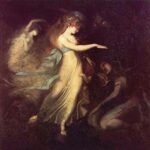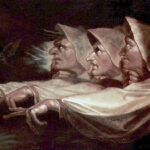Henry Fuseli (1741–1825) was a Swiss-born British Romantic artist, born Johann Heinrich Füssli at Zürich, Switzerland on 6 February 1741. He initially trained as a Zwinglian minister, and was ordained in 1761, but soon abandoned the priesthood,[1] and in 1764 moved to England, where he met Sir Joshua Reynolds, who encouraged him to concentrate on becoming a painter.[2]
Much of Fuseli’s work derives from his fascination with the horrifying and fantastic, exploring “the murky areas of the psyche where sex and fear meet”. His reputation was secured when The Nightmare
Oil painting by Henry Fuseli, depicting an ape-like incubus crouching on a sleeping woman, first exhibited at the Royal Academy in 1782. was exhibited at the Royal Academy in 1782, depicting a sleeping woman in the grip of a darkly erotic dream.[2]
Gallery
See also
- Fairy paintingGenre of art and illustration featuring small imaginary human-like creatures with magical powers, often with wings.







